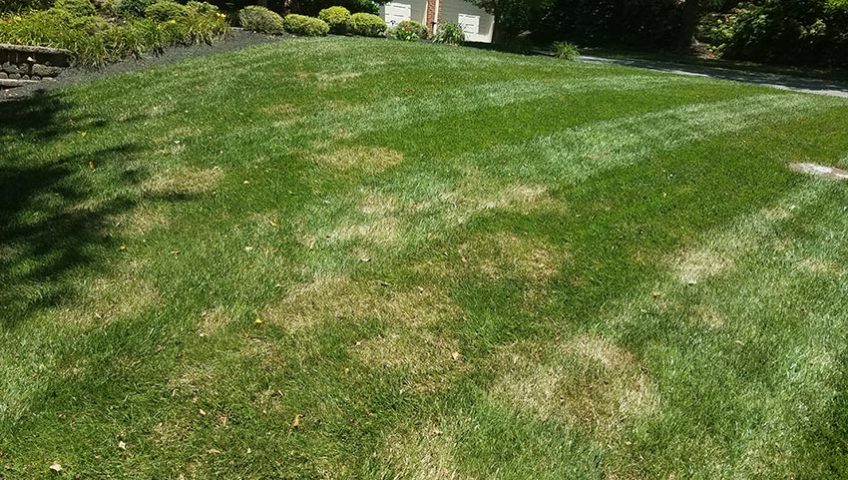In this post we are going to scratch the surface of the importance of fertilizing your lawn in Columbia,MO. This starts with understanding what is in the fertilizers that you are using, when to use them and the precautions that you need to take to prevent any damage to your lawn.
First, we will cover general processes for applying fertilizer to your lawn. Before applying fertilizer, it is a good idea to test your soil to determine the nutrient levels and pH balance. This will help you determine the right type of fertilizer as well as the appropriate amount to apply. There are many different types of fertilizers available, each with their own blend of nutrients and application instructions. It is vital that you choose a fertilizer that’s appropriate for your grass type and the time of year. Use a spreader to apply the fertilizer evenly across your lawn, making sure to follow the instructions on the package for proper usage. Spreading the fertilizer evenly across your lawn helps avoid “burning” or damaging the grass.
After applying the fertilizer, water your lawn thoroughly to help the nutrients penetrate the soil and reach the roots. Be sure to water your lawn deeply but infrequently, rather than giving it frequent, shallow watering. In addition, you should clean up any excess fertilizer that lands on sidewalks or driveways by sweeping it up and disposing of it properly, as it can wash into storm drains and contaminate water sources. When handling and applying fertilizer, be sure to follow any safety precautions listed on the package, such as wearing gloves or eye protection, and keeping children and pets away from the treated area for the specified period of time.
What is in Lawn Fertilizers?
Lawn fertilizers typically contain a combination of nitrogen, phosphorus, and potassium (known as NPK), as well as other essential nutrients such as sulfur, magnesium, and calcium. The specific amounts of each nutrient may vary depending on the brand and type of fertilizer. Nitrogen is typically the most important nutrient for promoting green, healthy grass growth while phosphorus supports root development and potassium helps to improve the grass’ overall resilience to environmental stressors like heat, drought, and disease. In addition to these primary nutrients, some fertilizers may also contain micronutrients like iron and zinc to further support grass health and growth.
When Should I Fertilize my Lawn in Columbia, MO?
For cool season grasses, such as those found in Columbia, MO and surrounding areas, it is generally recommended to fertilize your lawn four to six times a year. Below is a general schedule to follow:
- Early Spring: Apply fertilizer in the early spring, just as the grass begins to actively grow. This helps to provide the nutrients needed to jumpstart growth and promote a healthy lawn.
- Late Spring: Apply a second round of fertilizer in late spring, around 6-8 weeks after the first application. This helps to maintain steady growth and keep the lawn healthy.
- Late Summer: Apply a fourth round of fertilizer in late summer, around 6-8 weeks after the late spring application. This continues to help maintain steady growth and keep the lawn healthy.
- Late Fall: Apply a final round of fertilizer in late fall, typically around September or October . This helps to provide nutrients for root growth and storage during the winter months, and prepares the grass for healthy growth in the spring.
What Can Happen if I Use Too Much Fertilizer?
Overusing fertilizer can have multiple negative consequences for your lawn and the environment. Listed below are a few potential effects of using too much fertilizer:
- Burned Grass: Overuse of fertilizer can lead to “burned” grass, or brown patches, on your lawn, as excess nitrogen can dry out and damage the grass. This is especially common if you apply fertilizer during hot or dry weather, when the grass is already stressed.
- Environmental Damage: Excess fertilizer can also leach into the soil and contaminate nearby water sources, leading to algae blooms, killing off large bodies of fish, and other harmful effects. This is particularly a concern if you live near a body of water or if you apply fertilizer on a slope or hill where it can easily runoff.
- Weakened Roots: Overuse of fertilizer can also lead to an imbalance in soil nutrients, which can harm the roots of your grass and make them more vulnerable to pests, diseases, and other environmental stressors.
- Increased Maintenance: Applying too much fertilizer can cause your grass to grow too quickly, which may require more frequent mowing and other maintenance tasks to keep your lawn looking healthy.
To avoid these negative effects, it is important to follow the specific instructions on the fertilizer package and only apply the recommended amount for your lawn type and size. You should also avoid applying fertilizer during hot or dry weather and be careful not to apply it near water sources or on steep slopes.
If you think you might be interested in a fertilization service in Columbia, MO, give Preferred Pest and Lawn a call at (573) 823-9269 to get your free quote!
Contact Us:
Preferred Pest & Lawn – 925 Sondra Ave. Columbia, MO 65202
Phone: 573-823-9269; Email: services@preferredpestmo.com
Website: www.preferredpestmo.com

